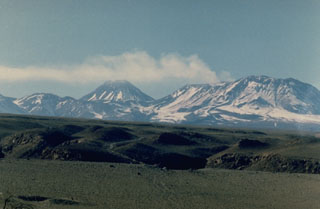Report on Lascar (Chile) — 15 February-21 February 2023
Smithsonian Institution / US Geological Survey
Weekly Volcanic Activity Report, 15 February-21 February 2023
Managing Editor: Sally Sennert.
Please cite this report as:
Global Volcanism Program, 2023. Report on Lascar (Chile) (Sennert, S, ed.). Weekly Volcanic Activity Report, 15 February-21 February 2023. Smithsonian Institution and US Geological Survey.
Lascar
Chile
23.37°S, 67.73°W; summit elev. 5592 m
All times are local (unless otherwise noted)
SERNAGEOMIN reported that during 15-21 February seismicity at Láscar continued to be dominated by volcano-tectonic signals with smaller numbers of both long-period and tornillo-type events. Daily whitish gas emissions were mostly diffuse, rose as high as 500 m above the crater rim, and drifted mainly E, SE, and W. Sulfur dioxide emissions were low, no notable deformation was detected, and no thermal anomalies were identified in satellite images. The Alert Level remained at Orange (the second highest level on a four-color scale) and SENAPRED warned the public to stay at least 10 km away from the crater. ONEMI maintained an Alert Level Yellow (the middle level on a three-color scale) for San Pedro de Atacama (70 km NW).
Geological Summary. Láscar is the most active volcano of the northern Chilean Andes. The andesitic-to-dacitic stratovolcano contains six overlapping summit craters. Prominent lava flows descend its NW flanks. An older, higher stratovolcano 5 km E, Volcán Aguas Calientes, displays a well-developed summit crater and a probable Holocene lava flow near its summit (de Silva and Francis, 1991). Láscar consists of two major edifices; activity began at the eastern volcano and then shifted to the western cone. The largest eruption took place about 26,500 years ago, and following the eruption of the Tumbres scoria flow about 9000 years ago, activity shifted back to the eastern edifice, where three overlapping craters were formed. Frequent small-to-moderate explosive eruptions have been recorded since the mid-19th century, along with periodic larger eruptions that produced ashfall hundreds of kilometers away. The largest historical eruption took place in 1993, producing pyroclastic flows to 8.5 km NW of the summit and ashfall in Buenos Aires.
Sources: Servicio Nacional de Geología y Minería (SERNAGEOMIN), Oficina Nacional de Emergencia-Ministerio del Interior (ONEMI)

